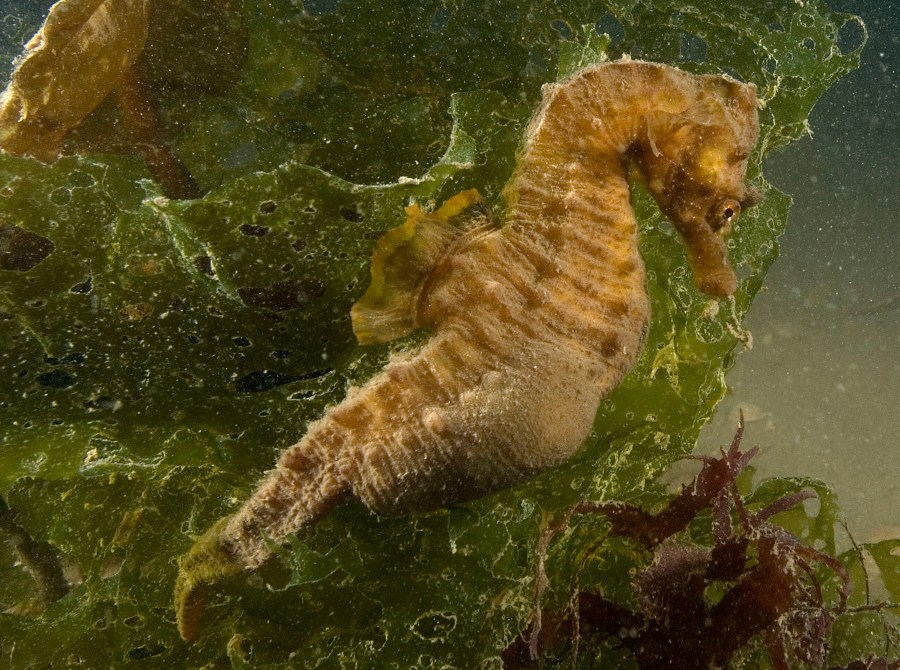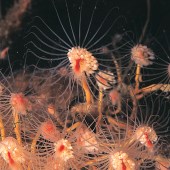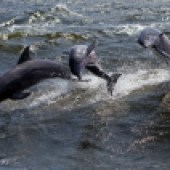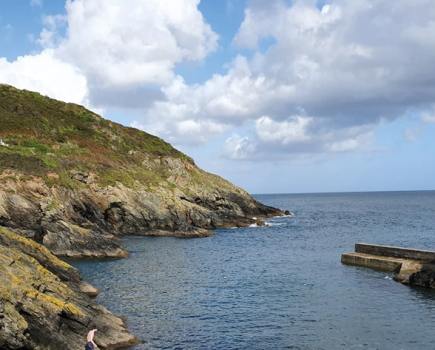Without national parks or areas of outstanding natural beauty our landscape would be very different, but what about our oceans and shores? Will marine conservation zones ensure their protection for the future? Words: Alex Fisher
Rockpooling is one of the great joys of the British seaside holiday; we all remember the excitement of finding a fish or tiny crab as young children. A day on the beach with a bucket and spade was often followed with a supper of fish and chips and a stroll over the sand to watch the sunset, and, if we were lucky, the glimpse of dolphins or seals in the waves.
These are memories we cherish, and ones we hope we can give our children, too. But will they be able to share the same experiences with their children? As the world population grows, pollution and modern fishing techniques are wreaking havoc on our marine ecosystems and unless we protect our seas now, these simple pleasures may become a thing of the past.
The landmark Marine and Coastal Access Act introduced the need for Marine Conservation Zones (MCZs) back in 2009. However, as many coast readers know, the consultation process to decide which places deserve our protection has been a long one. A panel of scientists recommended that 127 areas were necessary to maintain marine life, but, so far, only 27 have been confirmed.
In January 2015, the consultation on a further 37 recommended zones in English waters takes place, and we will have just three months to let the Government know if we feel these areas need to be preserved. Richard Harrington from the Marine Conservation Society says: ‘This doesn’t mean that these will ever be no-go areas, or that fishing will be banned here. While it hasn’t been decided precisely how these places will be managed, it is important that they are accepted as special places for wildlife that deserve to be protected in future.’
THE PLACES WE LOVE
Areas that will be consulted upon range from the Cromer Shoal Chalk Beds off the Norfolk Coast, to the Needles, the iconic chalk stacks that tower out of the sea on the west of the Isle of Wight. Each and every one of the zones provides important, and sometimes unique, habitats for British wildlife, which we love to watch, but in the case of fish, we also love to eat! The chalk beds of Cromer are important spawning grounds for both Dover and lemon sole, as well as whiting and sandeel. The North Norfolk coast is famous for its fishing industry and seafood restaurants, and without this spawning area, these businesses may come under threat.
In contrast, the chalk reefs beneath the Needles are a rich habit for seaweed and rare stalked jellyfish. Off the Berwickshire coast, Farnes East is home to a grey seal colony and harbour porpoises, along with puffins, cormorants and oystercatchers. Lovers of Cornwall will be pleased to hear that both the sea just off Land’s End and the coast around Newquay is also under consideration. As a lucky few of us have experienced, here you might see bottlenose dolphins, basking sharks and even minke whales. Without these protected areas, these species could be lost to England forever, and sightings of them no longer part of the classic British holiday.
‘The ultimate aim, and that which was shared by the scientists who came up with the original 127 zones,’ explains Richard, ‘was that it would create a network around the whole of the British Isles, rather than just isolated “islands” of wildlife. This network is essential to maintain the breeding and feeding grounds for many marine animals, which may move between zones at different times of the year. It also contains representative features – by that I mean fine examples of what is commonly found on the seabed – so that a range of life-supporting habitats can be safeguarded.
This is why we have to argue for every specified zone to be protected. Everything is connected in underwater ecosystems, and the preservation or loss of areas would have a knock-on effect on different species. If sandeel numbers go down, this affects cod, haddock and familiar seabirds like puffin, as this is one of their staple foods. People don’t understand that if they take one thing out of the food chain by damaging its habitat, they’ll lose other species, too. If we want fish and chips to continue to be a national dish, we need to protect sandeels, and so on.
‘We have been given a unique opportunity to preserve our marine ecosystems for generations to come, and I have great faith in the passion people have for the coast. I’m sure they will want to take action to ensure this happens. Other parts of the UK, including Scotland and Wales, will conduct their own consultation at a later date, but right now is the time to speak up for England.’
WHAT YOU CAN DO
One of the main issues is communication and knowledge. Many people may not be aware of the limited consultation period, so it’s important to pass on this information. Just letting as many people know about this opportunity is the first step.
As well as writing to your MP, details of the method of consultation will be posted on the Marine Conservation Society’s website (mcsuk.org/mpa) in early January (after this issue goes to press).
We’d love to hear your views on what areas you’d like protected. Contact us on our Facebook page at facebook.com/coastmagazine and on twitter @coastmag.
The Marine Conservation Society is a UK charity that cares for our seas, shores and wildlife. Its work involves campaigning for the preservation of marine wildlife in the UK, and some of our readers will know Richard from the coast Beach Clean outings (mcsuk.org).
Zones being considered FOR PROTECTION:
- Coquet to St Mary’s
- Farnes East
- Runswick Bay
- Compass Rose
- Holderness Inshore
- West of Walney
- Mud Hole
- Allonby Bay
- Fulmar
- Slieve Na Griddle
- South Rigg
- Cromer Shoal Chalk Beds
- Swale Estuary
- Dover to Deal
- Dover to Folkestone
- Offshore Brighton
- Offshore Overfalls
- Utopia
- Bembridge
- Norris to Ryde
- Yarmouth to Cowes
- The Needles
- Studland Bay
- Bideford to Foreland Point
- North of Lundy
- Mounts Bay
- Land’s End
- Newquay and the Gannel
- Hartland Point to Tintagel
- Western Channel
- Northwest of Jones Bank
- Greater Haig Fras
- South of Celtic Deep, Celtic Sea
- Celtic Deep, Celtic Sea
- East of Celtic Deep, Celtic Sea
OFF-SHORE WELSH WATERS: - Mid St George’s Channel
- North St George’s Channel
To see a map of where these zones are, go to mcsuk.org/mpa/details
Without national parks or areas of outstanding natural beauty our landscape would be very different, but what about our oceans and shores? Will marine conservation zones ensure their protection for the future? Words: Alex Fisher
Rockpooling is one of the great joys of the British seaside holiday; we all remember the excitement of finding a fish or tiny crab as young children. A day on the beach with a bucket and spade was often followed with a supper of fish and chips and a stroll over the sand to watch the sunset, and, if we were lucky, the glimpse of dolphins or seals in the waves.
These are memories we cherish, and ones we hope we can give our children, too. But will they be able to share the same experiences with their children? As the world population grows, pollution and modern fishing techniques are wreaking havoc on our marine ecosystems and unless we protect our seas now, these simple pleasures may become a thing of the past.
The landmark Marine and Coastal Access Act introduced the need for Marine Conservation Zones (MCZs) back in 2009. However, as many coast readers know, the consultation process to decide which places deserve our protection has been a long one. A panel of scientists recommended that 127 areas were necessary to maintain marine life, but, so far, only 27 have been confirmed.
In January 2015, the consultation on a further 37 recommended zones in English waters takes place, and we will have just three months to let the Government know if we feel these areas need to be preserved. Richard Harrington from the Marine Conservation Society says: ‘This doesn’t mean that these will ever be no-go areas, or that fishing will be banned here. While it hasn’t been decided precisely how these places will be managed, it is important that they are accepted as special places for wildlife that deserve to be protected in future.’
THE PLACES WE LOVE
Areas that will be consulted upon range from the Cromer Shoal Chalk Beds off the Norfolk Coast, to the Needles, the iconic chalk stacks that tower out of the sea on the west of the Isle of Wight. Each and every one of the zones provides important, and sometimes unique, habitats for British wildlife, which we love to watch, but in the case of fish, we also love to eat! The chalk beds of Cromer are important spawning grounds for both Dover and lemon sole, as well as whiting and sandeel. The North Norfolk coast is famous for its fishing industry and seafood restaurants, and without this spawning area, these businesses may come under threat.
In contrast, the chalk reefs beneath the Needles are a rich habit for seaweed and rare stalked jellyfish. Off the Berwickshire coast, Farnes East is home to a grey seal colony and harbour porpoises, along with puffins, cormorants and oystercatchers. Lovers of Cornwall will be pleased to hear that both the sea just off Land’s End and the coast around Newquay is also under consideration. As a lucky few of us have experienced, here you might see bottlenose dolphins, basking sharks and even minke whales. Without these protected areas, these species could be lost to England forever, and sightings of them no longer part of the classic British holiday.
‘The ultimate aim, and that which was shared by the scientists who came up with the original 127 zones,’ explains Richard, ‘was that it would create a network around the whole of the British Isles, rather than just isolated “islands” of wildlife. This network is essential to maintain the breeding and feeding grounds for many marine animals, which may move between zones at different times of the year. It also contains representative features – by that I mean fine examples of what is commonly found on the seabed – so that a range of life-supporting habitats can be safeguarded.
This is why we have to argue for every specified zone to be protected. Everything is connected in underwater ecosystems, and the preservation or loss of areas would have a knock-on effect on different species. If sandeel numbers go down, this affects cod, haddock and familiar seabirds like puffin, as this is one of their staple foods. People don’t understand that if they take one thing out of the food chain by damaging its habitat, they’ll lose other species, too. If we want fish and chips to continue to be a national dish, we need to protect sandeels, and so on.
‘We have been given a unique opportunity to preserve our marine ecosystems for generations to come, and I have great faith in the passion people have for the coast. I’m sure they will want to take action to ensure this happens. Other parts of the UK, including Scotland and Wales, will conduct their own consultation at a later date, but right now is the time to speak up for England.’
WHAT YOU CAN DO
One of the main issues is communication and knowledge. Many people may not be aware of the limited consultation period, so it’s important to pass on this information. Just letting as many people know about this opportunity is the first step.
As well as writing to your MP, details of the method of consultation will be posted on the Marine Conservation Society’s website (mcsuk.org/mpa) in early January (after this issue goes to press).
We’d love to hear your views on what areas you’d like protected. Contact us on our Facebook page at facebook.com/coastmagazine and on twitter @coastmag.
The Marine Conservation Society is a UK charity that cares for our seas, shores and wildlife. Its work involves campaigning for the preservation of marine wildlife in the UK, and some of our readers will know Richard from the coast Beach Clean outings (mcsuk.org).
Zones being considered FOR PROTECTION:
- Coquet to St Mary’s
- Farnes East
- Runswick Bay
- Compass Rose
- Holderness Inshore
- West of Walney
- Mud Hole
- Allonby Bay
- Fulmar
- Slieve Na Griddle
- South Rigg
- Cromer Shoal Chalk Beds
- Swale Estuary
- Dover to Deal
- Dover to Folkestone
- Offshore Brighton
- Offshore Overfalls
- Utopia
- Bembridge
- Norris to Ryde
- Yarmouth to Cowes
- The Needles
- Studland Bay
- Bideford to Foreland Point
- North of Lundy
- Mounts Bay
- Land’s End
- Newquay and the Gannel
- Hartland Point to Tintagel
- Western Channel
- Northwest of Jones Bank
- Greater Haig Fras
- South of Celtic Deep, Celtic Sea
- Celtic Deep, Celtic Sea
- East of Celtic Deep, Celtic Sea
OFF-SHORE WELSH WATERS: - Mid St George’s Channel
- North St George’s Channel
To see a map of where these zones are, go to mcsuk.org/mpa/details









